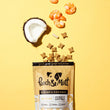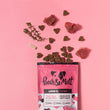FREE UK DELIVERY ON ORDERS OVER £39.99
A well-behaved dog is a well-trained dog. And for most dogs, their training starts early - when they’re still puppies. Training your puppy can be fun and an important way to develop your bond, but it can also be a challenge without tasty incentives. Here’s where dog treats come in! They’re key to a good puppy-training session, as puppies love to perform if there’s a munchable reward in store.
There are so many different dog treats on the market, however, not all are created equally. Treats that contain additives or sugars may even cause your pup to misbehave, the opposite of what you’re intending. So what are the most suitable treats for training your puppy?
Let’s get into what’s what when it comes to dog treats and puppy training…
When you’re buying treats for your puppy, you’ll realise quickly that there are so many options. Different flavours, sizes, textures, types - how do you know if your pup will even like them? It’s true, puppies can be picky eaters, and there’ll be a period of trial and error as you try to work out what floats their boat.
At first, perhaps buy a selection of treats, then experiment with which ones your puppy responds well to. Do they go tail-wagging mad for certain treats, but turn their nose up at others? Importantly, pay attention to the ones they seem to take a dislike to - these will be useless when it comes to training.
Though you’ll want to get your puppy all kinds of treats at first, there should be a level of quality you want to stick to. Your pup should be getting treats they not only find irresistible, but that provide nutrition, too.
Here are some factors to consider when shopping for healthy, tasty puppy treats:
There are also specialist dog treats, such as:
During training sessions, the number of treats you dispense to your puppy can start to tot up, making it unhealthy for pup if the treats have little nutritional value. The last thing you want is for your puppy to get hyped up on sugar, or to gain an unhealthy amount of weight when they’re still growing.
That’s why it’s so important to pick high-quality, nutritious treats that nourish a baby pooch’s delicate digestive system. Healthy treats will have them feeling calm, happy and energised - their ideal state at all times, but also ideal for training.
As puppies' stomachs are sensitive, a good treat for puppies will also contain minimal ingredients, stripped back to only natural, whole foods and without any artificial flavours or nasty additives. Extra health boosting elements, like probiotics, are an added bonus!
So, you’re stocked up with treats your puppy goes mad for - now it’s time to use them in a training session. Offering treats as positive reinforcement helps your pup learn that they’ll be rewarded for good behaviour, until eventually, they’ll hopefully do what you ask without encouragement.
Here’s what Vet Linda has to say about rewarding your pup with treats during training:
“Owners sometimes assume that their pup should 'want' to do as they ask and that rewarding desired behaviour with treats is 'spoiling' them. This could not be further from the truth! We need treats to motivate and reward our puppies to ensure they develop into well-behaved and polite adults. Treats are an absolute staple during every single puppy training session and help reinforce good behaviour, as well as strengthening your bond with your pup.”
So when using treats during training, try to remember the following:
Now you’re ready with pocketfuls of treats, here are some final questions before you get on with training your pup…
The most important factor when choosing puppy treats for training is that your puppy finds them delicious (otherwise they won’t work as a bribe!), that they’re made with nutritious ingredients and don’t contain artificial nasties, and that they’re small and munchable enough for your pup to quickly devour.
The amount of treats your puppy should eat depends on the recommended daily calorie allowance for their breed and age. Generally, treats should only make up 10% of their overall daily calories - check the packaging to work out calories-per-treat, and calculate a daily treat amount.
Delicious yet healthy treats are the best option when training a puppy. Choose treats that use natural ingredients, are free from artificial nasties, and are small enough for puppy mouths! You can use dog treats for crate training, toilet training, beginner tricks or teaching your puppy to go walkies with you. The possibilities are endless!
Never miss a treat!
Subscribe to our newsletter and get blog articles amongst other treats delivered to your inbox




Comments (0)
Leave a comment